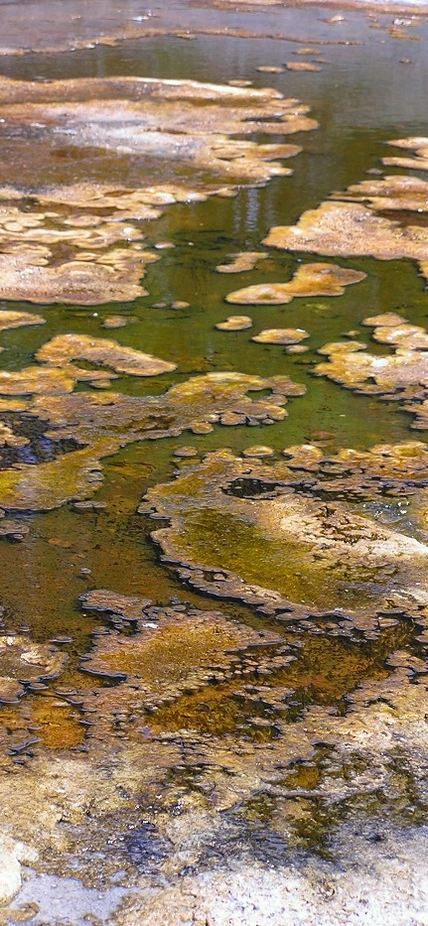Stanford, CA— New work from a team including Carnegie’s Devaki Bhaya and Michelle Davison used massive DNA sequencing of bacterial populations that grow in the hot springs in Yellowstone National Park to determine their genetic diversity and explore the underlying evolutionary dynamics. They found an unexpectedly high degree of sharing and exchange of genetic material between the tiny, green, photosynthetic cyanobacteria Synechococcus, which are abundant in these scalding, inhospitable environments.
The team discovered that the pattern of differences in genome organization between various individuals of the same species indicates that the bacteria transfer DNA, including whole genes, back and forth. This swapping or “recombination” allows gene variations to spread rapidly through a population. Their findings are published by Science.
There is a great deal of small-scale genetic diversity in naturally occurring bacterial populations—as opposed to the carefully managed bacterial clones used in laboratory research and clinical work. Bacterial populations in the natural environment represent a dynamic genetic resource that changes over time, but the quantification of this diversity, and the exact mechanisms creating its dynamics, has remained elusive.
“Biologists have long been interested in determining the evolutionary and ecological forces that drive the population genetics of bacterial communities,” Bhaya explained.
The research team, which also included lead author Michael Rosen as well as Daniel Fisher, both of the Applied Physics Department at Stanford University, set out to investigate this question by combining the power of so-called “deep sequencing” ( highly detailed and extensive DNA sequence determination) with powerful statistical analysis.
Several possible scenarios were considered. For instance, one theory predicts that bacterial populations are genetically diverse because they adapt to their surrounding conditions on a very small-scale, local level, leading to the establishment of distinct subpopulations, called ecotypes.
Another possibility was that all of the diversity in the bacterial genes is ‘neutral’—no particular version of a gene makes an organism more or less fit for its environment. Bacteria reproduce by asexual division, which means that each new generation is stuck with a nearly exact replica of its sole parent’s genetic material. Genetic changes can occur through mutation or the transfer of segments of DNA between individual organisms.
Using sophisticated statistical analysis of the massive “DNA deep sequencing” data enabled the team to trace the evolutionary forces that shaped these natural Synechococcus populations. They found that neither models of neutral drift, nor the concept of micro-niches of different ecotypes fit the data.
Rather, the population occupies a broad niche that includes a range of environmental conditions. Diversity is created by frequent swapping of genetic material between organisms. This apparently happens often enough that the population can be viewed as “quasi-sexual” in comparison to organisms like humans, where the process of sexual reproduction, specifically fertilization, combines genes from two parents.
In sexual reproduction, new combinations of genes are the rule. Although this is not generally true for bacterial populations, for these particular hot spring bacteria, new combinations are also the rule, rather than the exception. Since DNA moves between individuals, a new generation will not be stuck with just a copy of its parental genes. Because of this level of variation, natural selection acts on the level of individual genes, not the whole genome. Transfers of DNA happen so much that bacteria can have all sorts of different combinations of genes and gene variants.
“Without deep sequencing and careful analysis, we never would have been able to detect and identify the forces at work and it will be exciting to discover if these insights extend to other microbial communities,” Bhaya noted. “Microbial diversity is found everywhere from deep sea vents to the human gut or in association with plant roots. Using methods such as single cell sequencing, proteomics, and microscopy will allow exploration of this invisible and important world with great accuracy and depth.”

Caption: Capturing tiers of complexity: from genomes to cells to hot spring microbial mat communities of Yellowstone National Park.
From left to right: Circos graph depicting extensive genomic rearrangements between two sequenced cyanobacterial genomes called Synechococcus OSA and OS-B’ (in red and blue respectively); a population of Synechococcus cells cultured in the lab exhibiting natural fluorescence; and a microbial mat community in Octopus Spring in Yellowstone National Park. Images are courtesy of Michelle Davison and Devaki Bhaya.
(Top caption: A microbial mat community in Octopus Spring, Yellowstone National Park, courtesy of Michelle Davison. A larger version is available here.)
----------
This work was supported by the National Science Foundation, the Carnegie Institution for Science, a Stanford Graduate Fellowship, and an IBM fellowship
